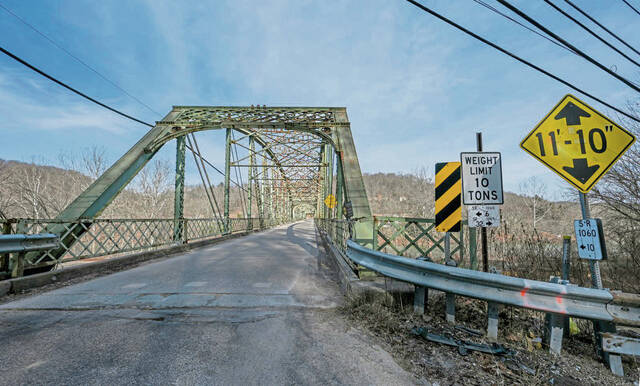Coming soon: Salina Bridge to be replaced, part of historic span to be kept for posterity
Replacement of the historic Salina Bridge that connects Bell and Kiski townships will cost $33 million.
The apparent low bidder for the project was Mekis Construction Corp. based in Fenelton, according to PennDOT.
Project manager Troy Pritts said he expects construction to start by spring.
The price tag includes additional work such as addressing a deteriorating nearby retaining wall, drainage improvements and upgrades at intersections. The new bridge will be built about 100 feet away from the existing span.
“The old bridge will remain in use until the new bridge is constructed and opened to traffic,” Pritts said, estimating the existing span could be dismantled over the 2025-26 winter. The project is expected to be complete in 2027, though traffic will be able to use the new bridge before that, he said.
It carries Bridge Street over the Kiski River and Norfolk Southern Railway tracks between Bell and Kiski townships. The bridge was last rehabilitated in 1978, but it can’t handle vehicles that weigh more than 10 tons, which includes fire trucks.
Discussions about replacing or rehabilitating the bridge, built in 1906, have been ongoing since 2018. The Salina Bridge is a pin- connected Parker Truss bridge, a model that became popular in the United States in the mid-1800s. The landmark is eligible for listing on the National Register of Historic Places.
An analysis of the project and existing span led PennDOT and the Federal Highway Administration to decide that replacing the bridge was the best option. Deconstruction was authorized after PennDOT was unsuccessful in finding a third party to take over ownership.
Several pieces of the bridge will be donated to the Bell Township Historical Society. In addition, the project calls for PennDOT to contribute $665,000 to the Historic Metal Truss Bridge Capital Rehabilitation Program to mitigate the loss of a historic property.
“There is a requirement in the construction contract to carefully remove and deliver the as-requested pieces of the existing bridge,” Pritts said.
Another means of mitigating the loss of a historic structure is the installation of interpretive panels. They will be put up during construction and remain after the work is complete.
“The panels will be placed at the trailhead for the Roaring Run Watershed Association,” Pritts said.
Those panels include information and photos of the 118-year-old bridge’s history and that of the towns it connects. Other panels bear information about the old Kier brick factory nearby and a 19th-century retaining wall on the northern bank of the Kiski River that was once part of the Western Division of the Pennsylvania Mainline Canal.
This story is updated to reflect the cost PennDOT would contribute to the Historic Metal Truss Bridge Capital Rehabilitation Program.
Renatta Signorini is a TribLive reporter covering breaking news, crime, courts and Jeannette. She has been working at the Trib since 2005. She can be reached at rsignorini@triblive.com.
Remove the ads from your TribLIVE reading experience but still support the journalists who create the content with TribLIVE Ad-Free.


